Click on images to enlarge
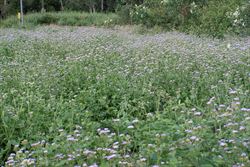
infestation (Photo: Trudy Baker)
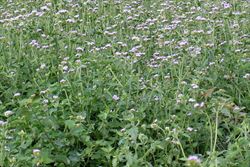
habit (Photo: Trudy Baker)
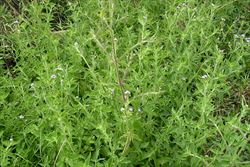
habit (Photo: Chris Gardiner)
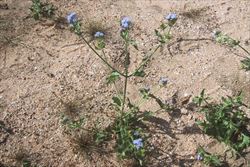
habit (Photo: Chris Gardiner)
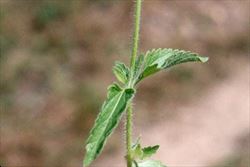
hairy stem and paired leaves (Photo: Chris Gardiner)

close-up of deeply toothed leaf (Photo: Trudy Baker)
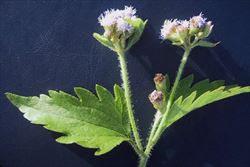
toothed leaves and clusters of flower-heads (Photo: Chris Gardiner)

close-up of flower-heads (Photo: Trudy Baker)
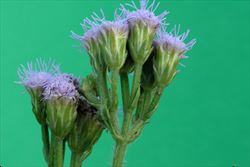
flower-heads from side-on showing bracts (Photo: Trudy Baker)
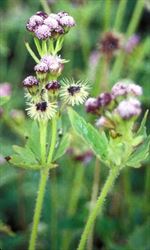
older flower-heads with 'seeds' (Photo: Trudy Baker)
Scientific Name
Praxelis clematidea (Griseb.) R.M. King & H. Robinson
Synonyms
Eupatorium catarium Veldk.Eupatorium clematideum Griseb.
Family
Asteraceae (Queensland, New South Wales, the ACT, Victoria, Tasmania, Western Australia and the Northern Territory)Compositae (South Australia)
Common Names
praxelis
Origin
Native to South America (i.e. southern Brazil, Bolivia, Peru, Paraguay and northern and central Argentina).
Naturalised Distribution
This species was first recorded near Tully in northern Queensland in 1993, but it has spread quickly and is now relatively widespread in the coastal districts of Queensland. It is most common in northern Queensland, particularly between Townsville and Mossman, but has also been recorded more recently from the more remote parts of Cape York Peninsula and a few locations in central (i.e. Gladstone, Yeppoon and Mackay) and south-eastern (i.e. Childers and Gympie) Queensland.
Also recently naturalised in south-eastern Asia (e.g. Taiwan, Hong Kong and mainland China).
Habitat
A weed of wetter environments in tropical and sub-tropical regions. It infests roadsides, railways, disturbed sites, waste areas, grasslands, pastures, open woodlands and stream banks. It also encroaches upon sugarcane plantations and other crops.
Habit
An upright (i.e. erect) and short-lived or long-lived (i.e. annual or perennial) herbaceous plant usually growing 20-80 cm tall, but occasionally reaching up to 1.2 m in height.
Distinguishing Features
-
a short-lived or long-lived herbaceous plant usually growing 20-80 cm tall.
-
its stems are hairy and bear leaves in pairs.
-
its leaves have deeply toothed margins with about 5-8 teeth on each side.
-
the leaves emit a foul odour when crushed.
-
its small flower-heads are purplish, blue or lilac in colour and its 'seeds' are topped with a ring bristles (3-4 mm long).
Stems and Leaves
The branched stems are rounded (i.e. terete) or angular and covered in long hairs (i.e. they are hirsute).
The leaves are oppositely arranged along the stems and borne on stalks (i.e. petioles) 3-20 mm long. The leaf blades (2.5-6 cm long and 1-4 cm wide) are egg-shaped in outline (i.e. ovate) to somewhat diamond-shaped (i.e. rhomboid) and have pointed tips (i.e. acute apices). They are hairy (i.e. hirsute), particularly underneath, and have deeply toothed (i.e. coarsely dentate) margins with about 5-8 large teeth on each side. The leaves emit a foul odour when crushed.
Flowers and Fruit
The small flower-heads (i.e. capitula) are borne in dense clusters at the tips of the branches (i.e. in terminal corymbs or cymes). Each flower-head (7-10 mm long and 4.5 mm wide) is borne on a hairy stalk (i.e. hirsute pedicel) 2-10 mm long. These flower-heads consist of numerous (25-50) tiny flowers (i.e. tubular florets) surrounded by about 20 green or yellowish-green coloured bracts (i.e. an involucre). The elongated (i.e. lanceolate or linear) bracts are sometimes purplish towards their pointed tips (i.e. acuminate or acute apices) and are hairless or have a few close-lying hairs (i.e. glabrous to appressed strigose). The tiny flowers (i.e. tubular florets) are purplish, blue or lilac in colour and consist of four or five petals that are fused into tiny tube (i.e. corolla tube) 3.5-4.8 mm long. Flowering occurs mostly during summer and autumn (i.e. from January to May), but some flowers may be present throughout the year.
The 'seeds' (i.e. achenes) are black in colour (2-3 mm long) and are topped with a ring (i.e. pappus) of 15-40 bristles (3-4 mm long).
Reproduction and Dispersal
This species reproduces only by seed.
These seeds are spread short distances by wind and water, and longer distances on vehicles, animals and clothing. They may also be dispersed as a contaminant of building and landscaping materials and in garden mulch.
Environmental Impact
Praxelis (Praxelis clematidea) is on the Alert List for Environmental Weeds, a list of 28 introduced plants that threaten biodiversity and have the potential to cause other environmental damage in Australia.
Legislation
Not declared or considered noxious by any state government authorities.
Similar Species
Praxelis (Praxelis clematidea) is very similar to billgoat weed (Ageratum conyzoides subsp. conyzoides) and blue billygoat weed (Ageratum houstonianum). It is also relatively similar to a common native plant known as vernonia (Cyanthillium cinereum). These species can be distinguished by the following differences:
- praxelis (Praxelis clematidea) leaves have tapered (i.e. cuneate) bases and deeply toothed (i.e. coarsely dentate) margins, with about 5-8 large teeth on each side of the leaf blade. The bracts surrounding each flower-head (i.e. involucral bracts) are hairless or have a few close-lying hairs (i.e. glabrous to appressed strigose) and fall off when the seeds are shed (i.e. they are deciduous). The seeds are topped with numerous (15-40) relatively large bristles (3-4 mm long).
- billgoat weed (Ageratum conyzoides subsp. conyzoides) leaves have broad (i.e. obtuse) or somewhat heart-shaped (i.e. sub-cordate) bases and finely toothed (i.e. serrate) margins, with numerous small teeth on each side of the leaf blade. The bracts surrounding each flower-head (i.e. involucral bracts) are hairless or have a few hairs (i.e. glabrous to sparsely pubescent) and remain in place when the seeds are shed (i.e. they are persistent). The seeds are topped with five relatively small bristle-like scales (0.5-3 mm long).
- blue billygoat weed (Ageratum houstonianum) leaves have broad (i.e. obtuse) or heart-shaped (i.e. cordate) bases and finely toothed (i.e. serrate) margins, with numerous small teeth on each side of the leaf blade. The bracts surrounding each flower-head (i.e. involucral bracts) are usually covered with sticky hairs (i.e. glandular pubescent) and remain in place when the seeds are shed (i.e. they are persistent). The seeds are topped with five relatively small bristle-like scales (1-3 mm long).
- vernonia (Cyanthillium cinereum) leaves have broad (i.e. obtuse) or tapered (i.e. cuneate) bases and irregularly toothed (i.e. crenate) or almost entire margins. The bracts surrounding each flower-head (i.e. involucral bracts) are hairless or have a few hairs (i.e. glabrous to sparsely pubescent) and remain in place when the seeds are shed (i.e. they are persistent). The seeds are topped with numerous (about 20) relatively large bristles (4-5 mm long).

